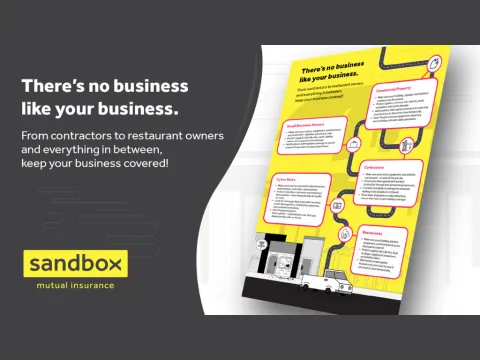
Preparing for Risky Business
Summary
Reading Time
7 min
Managing risk is an essential part of every business, large or small, states the Insurance Bureau of Canada: “Theft, fire, vandalism, riots: A host of perils could come your way and you need to be ready for them. You can help control the cost of your insurance premiums and improve your business operations by adopting risk management strategies.”
Many small business owners do not see the benefit of practicing risk management, says Tony Lackey, principal, TL Risk Solutions and lead instructor for the risk management courses at Carleton University.
“However, statistics prove that engaging in proper risk management procedures enhances the effective and efficient operations of a business,” says Lackey. “Retaining the services of risk a management expert is always recommended. These individuals can identify gaps in your processes and procedures and can make additional recommendations on risk mitigation strategies for specific premises and businesses. Another key resource for identifying risks and mitigation strategies is your insurance broker, who will have similar type clients and can recommend best practices.”
An experienced insurance broker can play a pivotal role in ensuring the adequacy of your insurance coverage, notes Justin Guillaume, supervisor, loss control & underwriting systems, Sandbox Mutual Insurance.
“Additionally, consider engaging risk management consultants who can assist in identifying, understanding, and effectively mitigating risks specific to your business,” says Guillaume. “Most business owners possess limited familiarity with insurance coverages and products. My recommendation is to collaborate with an experienced insurance broker who is willing to conduct on-site visits to thoroughly comprehend your business operations specific risks and unique needs. This personalized approach ensures the identification of appropriate coverage options tailored to your circumstances.”
If your objective is to effectively reduce losses, implementing an internal inspection or loss control program should be the first line of defense, says Guillaume.
“This program serves to detect vulnerabilities and proactively address them before they escalate into significant losses,” says Guillaume. “Initially, there is no need for elaborate measures. Simply conduct routine inspections by familiarizing yourself with the property and operational processes and look for any changes that develop over time. Pay attention to trip hazards, any equipment or building components that are showing signs of wear and tear, any pooling water or staining that was not there before, to name a few.”
An emergency response plan (ERP) is a form of risk mitigation strategy that helps businesses deal with an emergency, says Lackey.
“An emergency response plan should provide procedures for staff as to what to do in the event of fire, burglary, or any of numerous other types of hazards,” says Lackey. “Emergency response plans are an element of a business continuity management (BCM) system. Having a contingency plan to ensure the business survives after the fire trucks leave is even more important than an emergency plan.”
The development and implementation of an emergency response plan (ERP) is a critical component of comprehensive risk management and mitigation strategies, says Leanne Cheng, partner, BlueShift Advisory and instructor at Simon Fraser University Continuing Studies.
“An ERP serves as a roadmap for convenience stores and carwashes, detailing specific actions to be taken in response to various emergency situations, including natural disasters, fires, medical emergencies, and other unforeseen events,” says Cheng. “An effective emergency response plan not only aims to protect the lives and safety of both customers and employees but also minimizes potential damage to property and business operations. By preparing for emergencies in advance, businesses can ensure a coordinated efficient response that significantly reduces the impact of such incidents.”
Each ERP should consider the specific needs of the business but Cheng notes the following as some of the more significant measures that can enhance the effectiveness of an ERP:
- Conduct regular emergency drills: Practice emergency response procedures with all employees to ensure everyone knows their role during an actual event.
- Establish clear communication channels: Have systems in place for quickly disseminating information to employees and customers during an emergency.
- Maintain emergency supplies: Keep a stock of emergency supplies, including first aid kits, flashlights, batteries, and other essentials, readily accessible.
- Develop an evacuation plan: Create a clear evacuation plan with marked exits and safe assembly points, ensuring it is well communicated to all employees and visibly posted for customers.
- Collaborate with local emergency services: Build relationships with local police, fire departments, and medical facilities to ensure a coordinated response when external assistance is required.
“By prioritizing the development and implementation of a detailed emergency response plan, convenience store and carwash owners can significantly bolster their preparedness for emergency situations,” states Cheng. “This proactive approach not only contributes to the safety and security of the establishment but also demonstrates a commitment to the well-being of employees and customers alike.”
Slip and fall incidents are among the most common accidents in retail and service environments, including convenience stores and carwashes, says Cheng.
“These incidents not only pose a significant risk to the safety and well-being of both customers and employees but can also lead to substantial legal and financial repercussions for the business,” says Cheng. “As such, taking proactive steps to mitigate these risks is essential.”
Cheng listed the following strategies as a few of the targeted measures that could be used to reduce the likelihood of slip and fall accidents:
- Keep floors clean and dry; immediately clean up spills.
- Install anti-slip floor mats in entranceways and wet/icy areas.
- Ensure good lighting in all areas to improve visibility.
- Use caution signs to warn of wet floors or potential hazards.
- Maintain outdoor areas, including parking lots and sidewalks, to prevent ice and snow accumulation.
- Lackey notes that slip and falls are one of the highest frequency risks for small businesses, such as convenience stores and gas stations. He advises that key mitigation strategies include:
- Regular maintenance of all walkways and aisles, ensuring that all floor surfaces are clean and dry.
- Ensuring all aisles are clear of any obstructions.
- When a floor becomes wet, ensure proper signage is put in place to warn patrons of the hazard.
- Maintain detailed records on all maintenance completed including the time when cleaning took place and any details on the way and quantity of wax, salt, or other treatments were applied.
- Ensure washrooms are cleaned on a regular basis and documented.
- If mats are used at the entrance and high traffic areas, make sure these mats are cleaned regularly and changed as necessary.

Everyone has a role to play when it comes to health and safety, says Mathew MacLeod, senior technical specialist, occupational health and safety, Canadian Centre for Occupational Health and Safety (CCOHS).
“It’s important to collaborate with workers, supervisors, and your health and safety representative, if you have one, to identify hazards and put control measures in place to protect workers,” says MacLeod. “Be sure to talk with workers and supervisors and encourage them to report any concerns. Remember to consult with all workers as they are often the most knowledgeable on the types of hazards they may encounter. In the case of convenience stores or carwash environments, some hazards could include working alone; violence and harassment; slips, trips and falls; manual material handling and ergonomics; and exposure to cleaning products or other chemicals.”
A hazard control program can help workplaces identify any hazard that may cause an incident, injury, or other harm and MacLeod advises to regularly evaluate the control measures you have in place to make sure they are effective and working as intended.
“This program is a set of workplace procedures adopted to prevent injuries, adverse health effects, and damage to the work environment or equipment,” says MacLeod. “Any workplace can experience an emergency and preplanning is essential. Having well thought out and comprehensive emergency response plans for each type of possible emergency can help make sure everyone knows their responsibilities and what to do to help prevent incidents, injuries, damage, and more serious consequences.”
Article written by Angela Altass, Convenience & Carwash Canada
Please note that the information in this article may not accurately reflect your insurance policy from Sandbox Mutual Insurance or another insurance company. Please refer to your policy or talk to your broker about your specific coverages.

FAQ'S
Do small businesses really need a risk management plan, even if they’re starting out?
Absolutely. Risks don’t wait until you’re “big enough.” Even new or home-based businesses face hazards such as slip-and-falls, equipment failures, weather damage, and cyber incidents. A basic risk management plan helps you spot vulnerabilities early, make informed decisions, and avoid costly surprises. Plus, it shows insurers (and lenders) that you take your business seriously — often helping with better coverage and smoother claims.
What’s the difference between an emergency response plan (ERP) and regular safety procedures?
Think of regular safety procedures as your everyday good habits — like keeping walkways clear or inspecting equipment. An ERP is your game plan for when things go wrong: fire, break-ins, floods, power outages, medical emergencies, and more. It outlines who does what, where people go, and how communication happens. An ERP doesn’t just protect your building — it helps protect your people and your business continuity once the immediate crisis is over.
How can an insurance broker help with risk management?
A great broker is more than someone who “sells insurance.” They act as a risk-management partner. Brokers can:
• Identify gaps in your current coverage
• Recommend best practices based on similar businesses
• Visit your location to assess real-world risks
• Help match you with coverage that fits your unique operations
• Offer insights from claims trends and industry standards
Basically, they help you avoid blind spots — and make sure your insurance actually works when you need it most. Find one of our brokers today!



